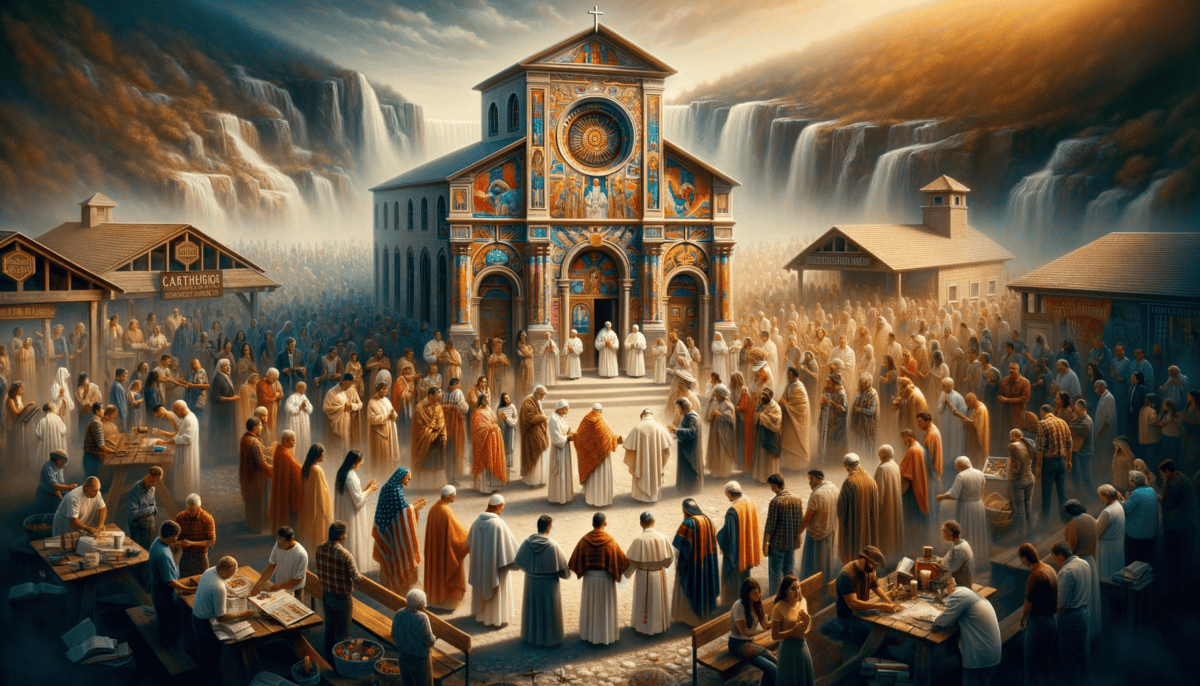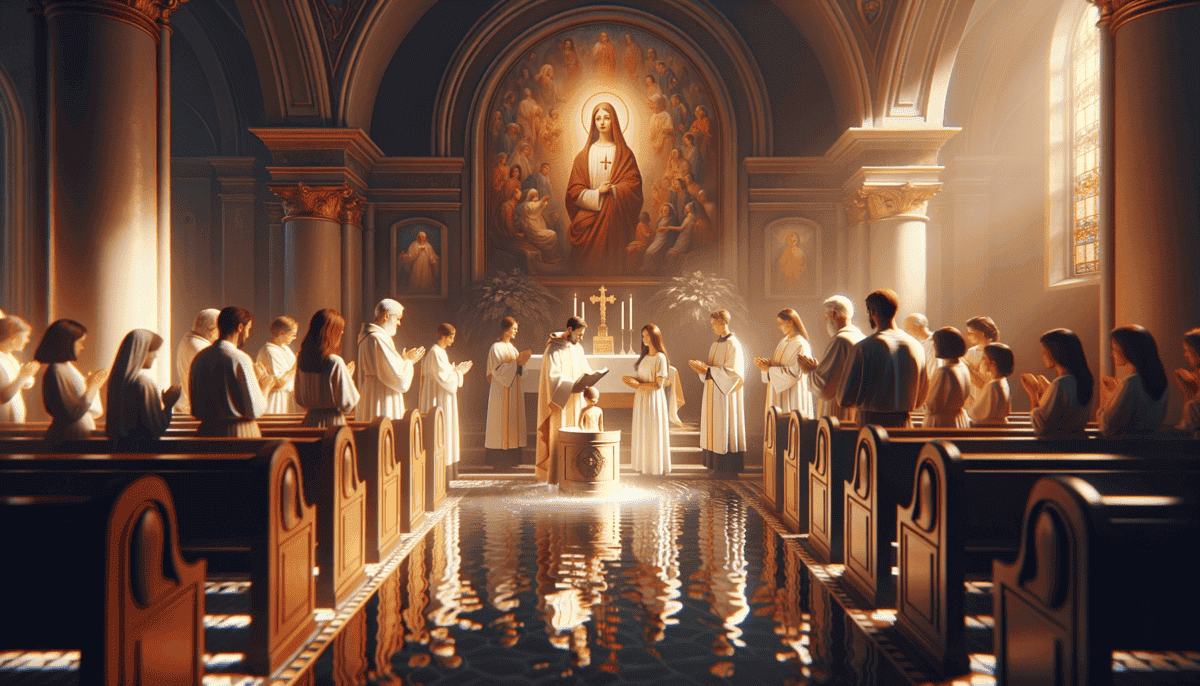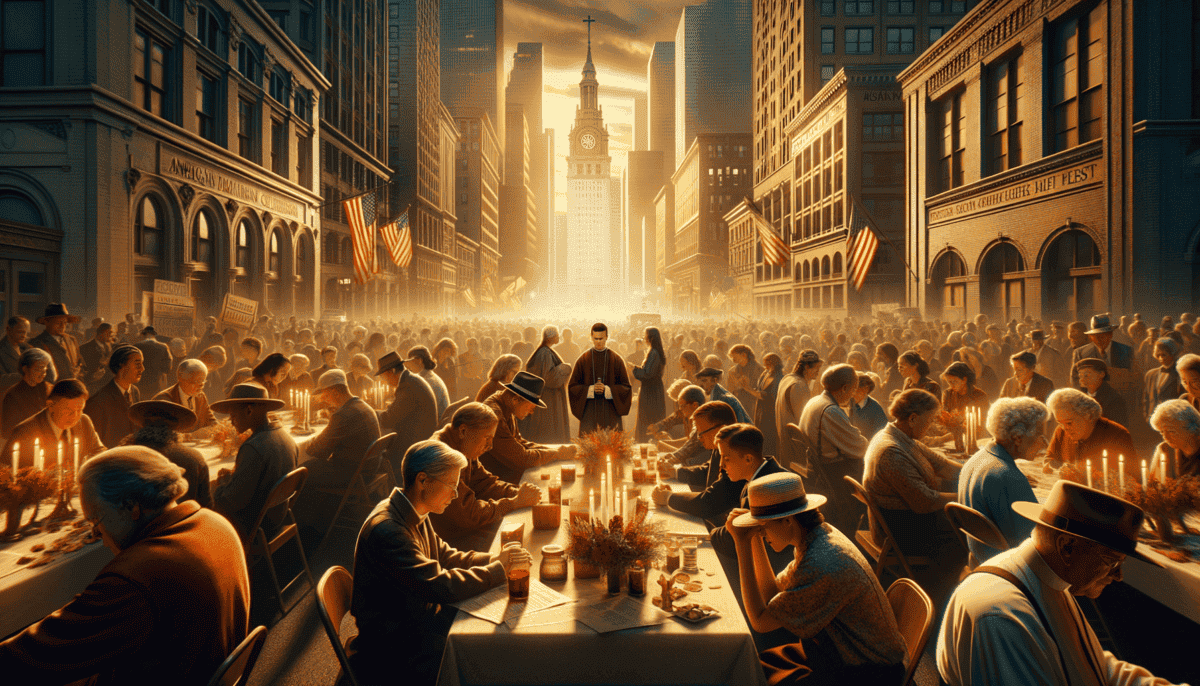The First Seeds
Little Maria squinted in the bright sun as she watched the strange ships appear on the horizon. The year was 1565, and she had never seen anything like these tall vessels approaching the shore of what would later be called Florida. 🚢
"Papa, who are they?" she asked, tugging at her father's sleeve. The native Timucuan girl and her father stood watching as Spanish missionaries stepped onto their land.
"They bring new stories about God," her father whispered, his voice filled with curiosity and caution.
A New Beginning
The missionaries wore long brown robes and carried wooden crosses. Father Antonio, their leader, smiled warmly at the local people. He had traveled across the vast ocean to share his Catholic faith with the people of this new land.
"We come in peace," Father Antonio said through a translator. "We wish to tell you about Jesus and build a place where we can all pray together."
Growing Faith
As years passed, more missionaries arrived. They came from Spain and France, bringing with them colorful vestments, golden chalices, and beautiful statues. They built simple wooden churches called missions.
Young native children like Maria learned new prayers and songs. The missionaries taught them about saints and angels. They shared bread and wine in special ceremonies called Mass.
"The building of missions wasn't always easy," Father Junipero Serra wrote in his diary. He was a brave priest who walked thousands of miles to build missions in California. His feet often hurt, but he never gave up. 👣
Working Together
The missions became busy places where people:
• Learned to read and write
• Grew food in gardens
• Made beautiful art
• Sang in choirs
• Helped sick people get better
“God’s love is like the sun – it shines on everyone,” Father Serra would often say to the children gathered around him.
Sharing and Learning
Maria grew older and taught her own children the prayers she learned. She showed them how to make the sign of the cross and told them stories about Jesus. The native people shared their own wisdom too, teaching the missionaries about local plants and how to survive in the new land.
"Look how the morning glory opens to the sun," Maria told the children. "That's how we should open our hearts to learn new things." 🌺
Building Bridges
Sometimes it was hard for the missionaries and native people to understand each other. They spoke different languages and had different ways of doing things. But they tried their best to be kind and patient.
Father Antonio wrote: "Today I learned to say 'thank you' in the Timucuan language. Small steps build strong bridges between hearts."
Small wooden crosses began to dot the landscape as more missions were built. The sound of church bells rang through forests where only bird songs had been heard before. 🔔
"Each day brings new challenges," Father Serra wrote, "but also new joys as we share our faith in this beautiful land."
The seeds of Catholic faith were taking root in American soil. Like tiny seeds that grow into strong trees, these first Catholic communities would grow and spread across the land, becoming part of the rich tapestry of American life.
"Remember children," Maria would say to her grandchildren, "faith is like a garden. We must tend it with love and care to help it grow strong."
Young native children and missionary students learned to sing together in the mission choirs. Their voices blended in harmony, creating something new and beautiful – just like the mixing of their two worlds. 🎵
Building Communities of Faith
The sun rose over a busy New York harbor in 1847. Young Patrick O’Brien stood on the deck of a crowded ship, watching the Statue of Liberty appear through the morning mist. 🗽
“Look Mama!” he exclaimed. “Is this really America?”
His mother smiled tiredly. They had left Ireland during the potato famine, joining millions of other Catholic immigrants seeking a new life.
New Beginnings in a New Land
The O’Brien family wasn’t alone. Ships brought Catholics from many places:
• Ireland and Italy
• Poland and Germany
• Mexico and Puerto Rico
• Philippines and Vietnam
Building Our Churches
Patrick watched in amazement as his community worked together to build St. Mary’s Church. Everyone helped – even children carried small bricks! 🏗️
“This will be our new home,” Father Michael told the workers. “A place where all are welcome to pray and celebrate together.”
“Each brick we lay is like a prayer reaching up to heaven,” said Mrs. Romano, an Italian immigrant who baked bread for the workers.
Schools for Everyone
Sister Mary Catherine rang the bell for the first day of school. Catholic schools were opening everywhere! 🔔
“Here, children learn reading and writing,” she explained. “But they also learn about God’s love.”
Little Rosa Martinez raised her hand. “Can I come to school too?” she asked shyly.
“Of course!” Sister Mary Catherine smiled. “Our school welcomes everyone.”
Different Foods, Same Faith
The church basement became a place where families shared their special foods after Mass. 🍝
“Try my pierogi!” called Mrs. Kowalski from Poland.
“And my pasta!” Mrs. Romano added.
“Don’t forget the tamales!” shouted Mrs. Garcia.
Working Through Hard Times
Sometimes people weren’t kind to Catholic immigrants. Signs said “No Catholics Allowed” in some stores. 😢
“Keep your head high,” Patrick’s father told him. “God loves everyone the same.”
The Catholic communities stayed strong together. They helped each other find jobs, homes, and schools.
Celebrating Together
Each group brought special ways to celebrate their faith:
The Irish had St. Patrick’s Day parades. 🍀
Italians celebrated the Feast of San Gennaro. 🎉
Mexican families shared Las Posadas at Christmas. ⭐
Filipino Catholics had beautiful Simbang Gabi services. 🌟
Growing Stronger
“Look how our church has grown!” Patrick exclaimed years later, now a grandfather himself. The small brick church had become a beautiful cathedral.
Inside, people prayed in different languages. Children from all backgrounds played together after Mass. The church halls echoed with music from many cultures. 🎵
Young Maria, a new immigrant from El Salvador, smiled as she watched her children join the church choir. “This feels like home,” she said.
“That’s because we’re all family here,” replied Mrs. O’Brien, Patrick’s daughter. “God’s family.”
The Catholic community kept growing and changing, like a beautiful garden with many different flowers. Each group added their own colors and traditions, making the American Catholic Church unique and special. 🌷
Sacred Moments: Our Special Celebrations
Little Maria bounced excitedly in her white dress. Today was her First Communion day! 👗
The Gift of Baptism
“Remember when we baptized you?” Maria’s mom showed her a photo. Baby Maria wore the same white dress that her grandmother had worn.
“Your cousin Miguel is getting baptized next week!” Dad smiled. “Want to know what happens?”
Maria nodded eagerly.
“The priest will pour water on Miguel’s head three times. Then he’ll say: ‘I baptize you in the name of the Father, and of the Son, and of the Holy Spirit.'” 💧
Growing in Faith
Tommy sat with his friends in religion class. They were preparing for Confirmation.
“Confirmation is like saying ‘yes’ to God,” Sister Rose explained. “You’re old enough now to choose to follow Jesus.”
“Will it hurt?” asked Sarah nervously.
“Not at all!” Sister Rose laughed. “The bishop will make a cross on your forehead with special oil. It’s called chrism.” 🕊️
First Communion Day
Maria stood in line with the other children. Her heart was beating fast.
“Body of Christ,” said Father John.
“Amen,” Maria replied, just like she practiced.
Healing and Forgiveness
James was nervous about his first confession.
“It’s like telling a secret to Jesus,” his mom explained. “Father Mike helps Jesus forgive us.”
After confession, James felt lighter, like a weight was gone. “That wasn’t scary at all!” he said. 🙏
Marriage: A Beautiful Promise
Maria’s sister Elena was getting married! The church looked beautiful with flowers everywhere. 💐
“Marriage is a special promise,” Father John said. “Elena and Michael are promising to love each other like Jesus loves us.”
Everyone clapped when they said “I do!”
Serving God’s People
Father Mike visited Maria’s class to talk about becoming a priest.
“Some people feel God calling them to serve in a special way,” he explained. “Priests and nuns help take care of God’s family.” 👨👩👧👦
Comfort When We’re Sick
When Grandpa was in the hospital, Father John came to visit.
“This is called Anointing of the Sick,” Mom explained. “The priest prays for people who are very ill.”
Grandpa smiled after Father John blessed him. “I feel God’s love,” he said. ❤️
Celebrating Together
The seven special celebrations are called sacraments:
| Baptism | Confirmation | Eucharist |
| Reconciliation | Marriage | Holy Orders |
| Anointing of the Sick | ||
Each sacrament helps us feel closer to God and each other. They mark important moments in our lives as Catholics.
That night, Maria looked at her First Communion photos. She saw her family, her church friends, and her big smile.
“These are more than just celebrations,” her grandmother said softly. “They’re moments when heaven touches earth.” ✨
Heroes Among Us: American Saints Who Changed Lives
Sarah stared at the beautiful stained glass window in her church. It showed a kind-faced woman helping children learn. “Who is that, Mom?” she asked. 🤔
Mother Seton’s Big Heart
“That’s Saint Elizabeth Ann Seton,” Mom smiled. “She was the first American-born saint! Want to hear her amazing story?”
“Elizabeth lost her mom when she was very little. Later, she became a mom to five children herself. But then something sad happened – her husband got sick and died.”
“What did she do then?” Sarah wondered.
“She decided to help others! She became a nun and started schools for poor children. Back then, many kids couldn’t go to school.” 👩🏫
Katharine’s Treasure Hunt
Tommy raised his hand in class. “Sister Rose, tell us about Saint Katharine Drexel!”
“Katharine was born into a very rich family. But instead of buying fancy things, she used her money to help others.”
“She built schools for Native American and African American children when others wouldn’t help them,” Sister Rose explained. “She gave away millions of dollars to help people learn!” 💝
Miracles and Kindness
Maria watched a video about Father Solanus Casey. He worked as a doorkeeper at his church.
“People came from everywhere to ask for his prayers,” Father John said. “He helped sick people feel better and gave food to hungry families.”
Modern Day Heroes
The class made a special project about American saints. Each student picked their favorite:
| Saint | Special Work |
| Elizabeth Ann Seton | Started Catholic Schools |
| Katharine Drexel | Helped Native and African American Children |
| Father Solanus Casey | Helped Sick and Poor People |
Following Their Example
“Can we be like them?” Tommy asked.
“Of course!” Sister Rose beamed. “Saints are regular people who did extraordinary things because they loved God and others very much.” ❤️
Making a Difference Today
The class decided to start their own helping project. They collected:
• Books for kids who need them
• Food for hungry families
• Letters for lonely elderly people
• Toys for children in hospitals
“Look!” Sarah exclaimed. “We’re doing saint-like things too!” 🌟
Everyday Heroes
That Sunday, Father John talked about modern heroes.
“You don’t need to be famous to be a saint,” he said. “Every time you help someone, you’re following in the footsteps of these great American saints.”
Sarah looked again at the stained glass window. Now she understood why Elizabeth Ann Seton was smiling. Helping others makes you happy too!
On the way home, she told her mom, “I want to be like the saints. I’m going to start by helping my little brother with his homework.” 📖
Standing Strong: How Catholics Face Today’s World
Miguel sat in his grandmother’s kitchen, watching her make tortillas. “Abuela, why do some of my friends go to different churches?” he asked. 🤔
A Rainbow of Faith
“Mi amor, our country is like a beautiful rainbow,” Abuela smiled. “Some people pray differently, and that’s okay. What matters is how we treat each other.”
Marching Together
In school, Ms. Rodriguez showed pictures of Catholics marching with Dr. Martin Luther King Jr.
“Many Catholics joined the fight for equal rights,” she explained. “They believed God made everyone special.” ✊
“When we see something wrong, we must help fix it. That’s what Jesus taught us to do.”
New Ways to Pray
Sofia noticed something different at church. “Dad, why are some prayers in Spanish now?”
“The Church wants everyone to understand,” Dad explained. “That’s why we have Mass in different languages.” 🗣️
Helping Earth
The parish kids started a garden. They learned about taking care of God’s creation:
• Growing healthy food
• Saving water
• Recycling trash
• Helping animals
“When we care for the Earth, we show love for God,” Father Mike said. 🌱
Young Catholics Speak Up
Isabella raised her hand in youth group. “How can we help homeless people?”
The teens made plans:
| Problem | How We Help |
| Hunger | Food Drive |
| Loneliness | Visit Seniors |
| Poverty | Share Clothes |
Family Changes
“Some families look different now,” Maria told her Sunday school teacher. “My cousin has two homes – one with mom and one with dad.”
“God loves all families,” Mrs. Chen smiled. “We help each other through hard times.” ❤️
Digital Faith
During the pandemic, Tommy watched Mass on his tablet. “It’s different,” he said.
“Yes, but God is with us everywhere,” Mom replied. “Even online!” 📱
Finding New Ways
The parish started fun activities:
✨ Movie nights about saints
🎨 Art classes for kids
🎵 Modern music at Mass
👥 Online prayer groups
Growing Together
“Sometimes things change,” Father Mike said during his homily. “But our love for God and each other stays the same.”
Miguel smiled at his Abuela. “Like your tortillas – the recipe is old, but they’re still perfect!”
“Sí, mi amor,” she laughed. “And like these tortillas, our faith keeps us warm and brings us together.” 🌮
Growing Faith: Young Catholics Light the Way
The sun peeked through the stained glass windows of St. Mary’s Church, where twelve-year-old Luna and her friends gathered for youth group. 🌅
New Voices, Same Love
“What makes you proud to be Catholic?” Sister Maria asked the group.
Luna raised her hand. “We help everyone, not just Catholics!” she beamed. “Like our food bank that feeds all families.” 🥫
Digital Disciples
Carlos showed the group his Catholic app. “I made this to help kids learn prayers,” he explained.
“That’s wonderful!” Father James smiled. “God’s love works through phones too!” 📱
“Being Catholic today means using new tools to share old truths.”
Earth Angels
The youth group started special projects:
• Green Church Gardens 🌱
• Help for Poor Families ❤️
• Friend Time with Elderly 👵
• Clean Parks Days 🌳
• Prayer Buddy Program 🙏
Global Family
Maria video-called Catholic kids in Mexico. “We’re like cousins!” she giggled.
Hope Heroes
| What We Do | Why It Matters |
| Visit Sick Kids | Share Joy |
| Help Animals | Care for Creation |
| Clean Beaches | Protect Earth |
Future Faith
“Our church is changing,” Sister Maria said. “But Jesus’s love stays the same.” 💖
The kids made a promise wall:
✨ “I will be kind to everyone”
🌟 “I will help Earth stay clean”
💫 “I will pray for peace”
⭐ “I will share with others”
Together Forever
“Remember,” Father James said, “you are the future of our Church. Your love makes it stronger!”
Special Moments
Luna looked at her friends singing together. Old hymns mixed with new songs. Traditional prayers joined modern words.
“This is what heaven looks like,” she whispered. “Everyone together, loving God in their own special way.” 🎵
Forever Faith
As the sun set, the kids released paper lanterns into the sky. Each light carried their hopes and dreams.
“Our Catholic faith is like these lanterns,” Sister Maria said. “It lights up the dark and shows others the way.”
Luna smiled at her lantern floating up. She knew that being Catholic meant being part of something bigger than herself – a family that stretched across time and space, always growing, always loving, always hoping. ✨
And as the stars began to twinkle above St. Mary’s Church, Luna and her friends joined hands, ready to carry their faith into tomorrow’s world, making it brighter one kind act at a time. 🌟






